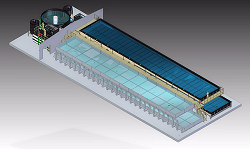Facility and equipment
The tanks
 The
size of the production tanks in a raceway-style is 35 x 5m with a
height of 75cm. The water level is adjusted at about 50cm. The
resulting water volume per tank is about 80 cbm. The farm operates
with four tanks. Two tanks are in the floor, two tanks above in the
first storey (see picture). Each two tanks are connected to its own
water recirculation unit (RAS). The tanks are constructed in two
different ways. Two tanks are made with a special high density
concrete (Ultralith / Nanodur) which does not need any metal
framework; two other tanks are built with special Polyethylene
boards in black. Apart from regular production, the shrimp farm in
Grevesmühlen is being considered as a demonstration facility, thus
the application of the two different tank constructions.
The
size of the production tanks in a raceway-style is 35 x 5m with a
height of 75cm. The water level is adjusted at about 50cm. The
resulting water volume per tank is about 80 cbm. The farm operates
with four tanks. Two tanks are in the floor, two tanks above in the
first storey (see picture). Each two tanks are connected to its own
water recirculation unit (RAS). The tanks are constructed in two
different ways. Two tanks are made with a special high density
concrete (Ultralith / Nanodur) which does not need any metal
framework; two other tanks are built with special Polyethylene
boards in black. Apart from regular production, the shrimp farm in
Grevesmühlen is being considered as a demonstration facility, thus
the application of the two different tank constructions.
Water quality
 The
farm is using artificial sea water which is based on fresh water
from a well. In the adaptation tanks for the larvae, the salinity is
initially adjusted of the origin of the larval stages from a farm in
Florida with about 36 psu. The salinity in the production tanks is
15psu. In an adaptation period, the salinity in the larval tanks is
decreased by 1psu/hour. The water temperature is kept around 30°C
in the production tanks. The air temperature in the facility is
about 31°C. This setting avoids significant evaporation of water
from the tanks. Thus, air humidity is kept closed to 70%. The water
filtration systems of the farm (RAS) operate continuously, keeping
the water clean and providing a healthy environment for the shrimp.
These recirculating systems work in several steps including solids
removal, biofiltration, CO2 removal, denitrification, protein
skimmer with ozonisation , UV-disinfection and oxygenation. The
removed sludge is discharged to the close sewage plant. The
operation of the farm based on RAS technique has the advantage that
the water quality can be precisely controlled and significantly
reduces the amount of water and space required. The water supply
rate is about 3-5% per day. The introduction of the water into the
tanks is managed by several inlets in order to ensure an equal water
quality in the entire tank. The water exchange rate in the
production tanks is 0.5 to 1 per hour.
The
farm is using artificial sea water which is based on fresh water
from a well. In the adaptation tanks for the larvae, the salinity is
initially adjusted of the origin of the larval stages from a farm in
Florida with about 36 psu. The salinity in the production tanks is
15psu. In an adaptation period, the salinity in the larval tanks is
decreased by 1psu/hour. The water temperature is kept around 30°C
in the production tanks. The air temperature in the facility is
about 31°C. This setting avoids significant evaporation of water
from the tanks. Thus, air humidity is kept closed to 70%. The water
filtration systems of the farm (RAS) operate continuously, keeping
the water clean and providing a healthy environment for the shrimp.
These recirculating systems work in several steps including solids
removal, biofiltration, CO2 removal, denitrification, protein
skimmer with ozonisation , UV-disinfection and oxygenation. The
removed sludge is discharged to the close sewage plant. The
operation of the farm based on RAS technique has the advantage that
the water quality can be precisely controlled and significantly
reduces the amount of water and space required. The water supply
rate is about 3-5% per day. The introduction of the water into the
tanks is managed by several inlets in order to ensure an equal water
quality in the entire tank. The water exchange rate in the
production tanks is 0.5 to 1 per hour.
Energy efficiency
 The
facility has a heat demand of 70 kWh. The annual demand for heating
energy is supposed to be 600 MW which is provided from a biogas
facility for a reasonable rate.
The
facility has a heat demand of 70 kWh. The annual demand for heating
energy is supposed to be 600 MW which is provided from a biogas
facility for a reasonable rate.
Laboratory
The facility has its own laboratory, equipped with all necessary means to monitor water quality and production parameter in general.